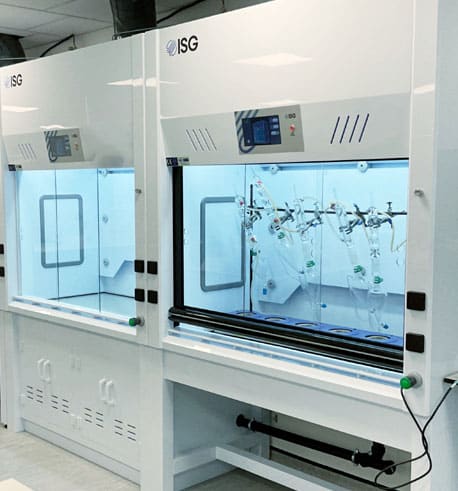
Fume hoods are a mainstay in laboratories and cleanrooms all over the world. Wherever chemicals and other potentially toxic substances are present, fume hoods are used to ensure that they are contained and treated in a safe way. It's imperative that they operate correctly and keep staff, samples, and the facility's atmosphere safe.
There are several key components that make up any fume cabinet, but one of the most important mechanisms within the apparatus is the ventilation system. Specifically, the speed of the airflow that captures any toxic contaminants and removes them from the system.
This airflow is highly regulated and must be regularly tested to ensure that the fume hood is operating as desired. In today's article, we're going to take a closer look at how to test the velocity of the airflow within a fume hood and why it's so important.
Fume hoods are compact and specially-designed ventilation units. They can be used to store hazardous materials and carry out experiments in a safe space while keeping staff members and the air within the facility clean. Effectively, they create a barrier between the potentially dangerous substances and the rest of the workspace. This protection is absolutely vital.
That being the case, fume cupboards need to be tested to ensure that they're ventilating and exhausting contaminated air in a suitable way. Air flow within the fume hood needs to be uniform in order to maintain negative pressure and prevent any pollutant escaping whenever the sash (or the door) is opened.
In fact, the rate of air flow is so important that with any fume hood design, it must meet the criterion as defined in the ANSI and ASHRAE 110 standards. This is the American standard for fume hood design and it even stipulates the methodology for testing the performance of fume hoods.
Testing the hoods ensures that the apparatus meets these criteria, that potentially hazardous substances are being processed and exhausted in an appropriate way, and that the working facility is safe for each member of staff.
These tests should be carried out (at least) annually and the apparatus should be certified each time.
It's recommended that the air flow velocity is somewhere between 0.3m/s and 0.5m/s, although there may be additional local regulations that impact this. So how is this speed confirmed?
With an operational fume hood, testing is recommended in two conditions: as installed, and as used.
There are numerous fume hood arrangements, with different air flow mechanisms and sash layouts. This means that there are slightly different ways to measure air flow, depending on the type of fume hood.
In principle, the tests will all endeavour to establish the same thing – that the average air flow face velocity meets the requirements.
The space within the fume hood is first divided into 9 equal sections. The sash is set up in its design position, and smoke is 'puffed' into the opening of the hood using ventilation smoke tubes. There should not be any smoke coming out of the hood.
Velocity readings are then taken at the centre of each of these 9 grid areas. The anemometer probe must be placed within the fume hood area to do this.
To ensure fair results, the probe must be placed in the same position each time (directly outward) and in line with the sash opening. A reading is recorded 9 times and an average value can be calculated at the end of the experiment.
The sash position is then reduced, and the fume hood area is instead divided into three areas, where the experiment is repeated under a new set of conditions.
Once the full suite of measurements has been recorded, they need to be analysed in order to determine whether or not the fume hood meets the required standard.
There is an ideal velocity range. If the face velocity is too fast (typically anything over 0.8m/s), then eddy currents may draw contaminants through the aperture. Too slow (usually less than 0.3m/s), and the fume hood may not be able to capture and contain contaminants.
Specialist examiners will be able to quickly identify whether or not the fume hood is operating correctly based on the results.
If your fume hood should fall short, then something must be done to correct the air flow velocity before the apparatus can be deemed suitable for use. Regardless, the fume hood must pass all of the criterion outlined in the ASHRAE 110 standards so that it can be certified and used again.
Fume hood velocity is an important factor no matter what type of hood is being used. Ensure that a regular servicing schedule is in place and work with the confidence that your procedures and staff members are safe.
To find out more about testing fume hood velocity, get in touch with our experts today.
Read our Privacy Policy for more information on how we collect and process data.



No thank you
Read our Privacy Policy for more information on how we collect and process data.